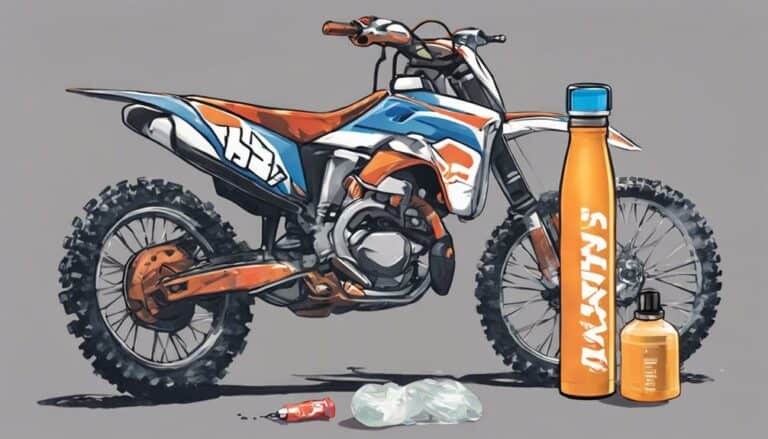When it comes to dirt bike gas tanks, they can be likened to the heart of your ride, holding the fuel that keeps you moving.
Have you ever wondered just how big these tanks can get? The size of a dirt bike gas tank is not one-size-fits-all; it varies depending on various factors.
Understanding the significance of the gas tank size can impact your riding experience in ways you might not have considered.
Key Takeaways
- Dirt bike gas tank sizes range from 1.3 to 3.2 gallons, with aftermarket options up to 6 gallons for varying riding experiences.
- Factors like bike make, model, and intended usage influence gas tank capacity decisions.
- Maximizing fuel efficiency involves riding techniques and aftermarket upgrades like larger tanks.
- Material choices for gas tanks impact weight, durability, and environmental considerations.
Dirt Bike Gas Tank Size
When considering dirt bike gas tank size, the range typically falls between 1.3 to 3.2 gallons, with potential for aftermarket tanks reaching up to 6 gallons in capacity.
The fuel capacity of a dirt bike is an important factor that directly impacts your riding experience. For those seeking to start their adventure or off-road journeys, larger tanks like the IMS Fuel aluminum gas tanks are a popular choice. These aftermarket options not only increase fuel capacity but also provide durability and resistance to the challenges of dirt biking.
On the other hand, motocross bikes often come equipped with smaller tanks to save weight and enhance maneuverability on the track. Understanding the dynamics of fuel capacity in the world of dirt biking allows you to tailor your ride to your specific needs, whether it be chasing the thrill of motocross or going on long-distance adventures through challenging terrains.
The choice between different tank sizes ultimately boils down to the kind of dirt biking experience you seek.
Factors Influencing Gas Tank Capacity
Factors influencing dirt bike gas tank capacity include the make and model of the bike, intended usage, and the potential for aftermarket upgrades. The size of the gas tank is primarily determined by the manufacturer's design choices, with dirt bikes ranging from 1.1 to 3.2 gallons on average. Racing bikes often opt for smaller tanks to reduce weight and enhance agility on the track. In contrast, enduro or trail bikes commonly feature larger tanks to accommodate longer rides without the need for frequent refueling.
Additionally, riders looking to extend their adventures can explore aftermarket tanks, which offer increased capacity beyond the stock options. These aftermarket tanks provide an opportunity to customize the bike according to specific needs, whether it be for endurance races or extended trail rides where access to gas stations may be limited. By considering these factors and potential upgrades, riders can tailor their dirt bike's gas tank capacity to suit their individual requirements for gas storage on various terrains.
Maximizing Dirt Bike Fuel Efficiency
To enhance the fuel efficiency of your dirt bike, consider optimizing your riding technique and exploring aftermarket upgrades for increased range. When it comes to fuel efficiency, the way you ride plays a significant role. Maintaining consistent speeds, avoiding sudden accelerations, and smooth gear changes can all contribute to maximizing the distance you can cover on a full tank. If you are planning longer rides or races, investing in an aftermarket larger capacity tank could be a game-changer. By increasing the size of your tank, you extend your bike's range, allowing you to go further without refueling frequently.
| Riding Technique | Effect on Fuel Efficiency |
|---|---|
| Consistent Speeds | Maximizes efficiency |
| Smooth Acceleration | Reduces fuel consumption |
| Gear Changes | Affects overall range |
Materials Used in Dirt Bike Gas Tanks
Commonly used in the construction of dirt bike gas tanks are materials such as plastic, aluminum, and carbon fiber. Plastic gas tanks, although lightweight and cost-effective, can be prone to cracking.
On the other hand, aluminum fuel tanks offer corrosion resistance and durability, but they come at a higher price point. Carbon fiber gas tanks are known for their strength, light weight, and resistance to corrosion; however, they're expensive to manufacture.
The choice of material for a dirt bike gas tank plays a significant role in determining factors such as durability, weight, and overall cost. When selecting a gas tank for your dirt bike, consider the trade-offs between the advantages and disadvantages of each material type to make sure that your fuel tank meets your specific needs.
Whether you prioritize affordability, durability, or weight savings, the material of your gas tank will directly impact your riding experience.
Environmental Impact of Dirt Bike Fuel Tanks
When considering the environmental impact of dirt bike fuel tanks, the materials used, such as polyethylene or aluminum, play an important role. Polyethylene tanks are lightweight, durable, and resistant to corrosion, making them a popular choice. However, they're derived from non-renewable resources and can have a higher environmental footprint crucial production and disposal compared to aluminum tanks, which are recyclable but heavier.
Proper maintenance of your dirt bike fuel tank, including checking the fuel cap for tightness and monitoring fuel levels to prevent overflows or leaks, is significant reducing environmental harm. Opting for aftermarket fuel tanks with larger capacities can also be a strategic move, as it can decrease the frequency of refueling stops, potentially lowering emissions generated during transportation.
When it comes time to replace your fuel tank, remember to recycle or dispose of the old one responsibly to minimize your ecological impact and promote sustainability.
Conclusion
You have learned about the importance of considering the size of a dirt bike gas tank when planning your rides.
By understanding the factors influencing gas tank capacity and maximizing fuel efficiency, you can guarantee a smoother and more enjoyable riding experience.
Remember, the right gas tank size can make all the difference in coinciding with your journey's needs.
Ride on with confidence and preparedness.

